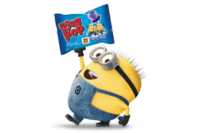Anyone in the food industry knows how vitally important packaging is. It doesn’t matter how delicious, nutritious or ambitious your product is — if it’s in a horrible package, nobody will ever buy it.
But it’s not just the wrapper that candy makers need to think about, when it comes to packaging. Confectionery coatings play just as vital of a role when it comes to luring customers into eating the delicious treat you’ve created.
“We at Capol think of candy coatings as surface treatment agents (polishes, sealants, anti-sticking agents, film formers), products which are used to enhance the final appearance of confections,” explains Michael Gordon, technical sales manager at Capol; and Katherine Clark, v.p. of sales at Capol.
And just as packaging continues to evolve with the times, so do coatings.
“In our segment of the industry, we have seen a shift toward cleaner “natural” ingredients and simplified/shorter ingredient statements,” Gordon and Clark explain. “We cater to this market with products made with ingredients accepted by the market as ‘natural’ as well as certified organic.”
Clasen Quality Coatings, Inc. is another company that’s adapted to the need for cleaner labels. They offer coatings that are Fair Trade-certified, Rainforest Alliance Certified and Non-GMO Project verification products. They also offer organic, hormone-free, and gluten-free coatings, as well coatings made with ingredients from members of RSPO (Roundtable on Sustainable Palm Oil).
The company also recently launched new dairy-free coatings.
“This new capability allows us to provide dairy-free products in all the varieties you’ve come to know and love from CQC, including pure chocolate,” the company says, although it’s not available in peanut or tree nut formulations.
The dairy-free claim can make a product vegan friendly, and it’s available Kosher Pareve upon request.
Along the same lines of cleaner labels, more companies also are adding health benefits to their coatings as way of attracting customers.
Clasen has a variety of coating options to meet the needs of the “better for you” snacking claims. Using CQC’s unique coating technology, they are able to enhance formulations with nutritional supplements such as fiber, protein and vitamins (just to name a few) for added health benefits.
They work hands-on with their customers to determine the proper load and delivery tolerances, without compromising the coating’s taste and functionality. These coatings are ideal for nutrition bars, energy bars, or other health-focused products.
And, at the 2013 International Baking Industry Exposition, Cargill featured a chocolaty peanut butter protein granola bar loaded with extra better-for-you ingredients.
The company used Wilbur 854 dark protein compound coating and Wilbur Y985 protein cocoa confectionery drops, both of which helped the bar met CFBAI standards for grain items. The bar also featured MaizeWise whole grain corn and Oliggo-Fiber chicory root fiber.
“One serving delivers a good source of protein and fiber, as well as 9 grams of whole grains for on-the-go nutrition that kids will enjoy,” the company says.
It was just one of the many products Cargill was featuring that had better-for-you ingredients.
“With a holistic approach in applying its broad ingredient portfolio and formulation expertise, Cargill food scientists have developed great tasting kid-friendly bakery items that contain less sodium, sugar and fat, and more whole grains, fiber and protein in accordance with specific childhood nutrition standard,” the company says.
Cargill says nutritive and fortified confectionery coatings are on trend.
“Concern about health and well-being is rising and consumers are looking for foods with health benefits,” the company says. “Nutritive claims are important because consumers want to be able to indulge while doing something good for their health.”
Protein especially is gaining interest as a long-term trend, not just a fad.
“Protein is not just about trying to build muscle, it’s also about weight control, satiety, healthier snacking and sport nutrition,” Cargill says. “Protein products have now become applicable to a wide audience from aging baby boomers and individuals trying to maintain or lose weight, to athletes and anyone seeking products that keep them fuller longer.”
Moreover, chocolate and protein pair especially well together.
“Wilbur Y854 cocoa confectionery protein wafers and Wilbur Y855 milk confectionery protein wafers are formulated with 20 percent total protein,” Cargill says. “Wilbur Y938 white chocolate protein drops are formulated with 10 percent total protein and meet the Standard of Identity for white chocolate. These drops have a great white chocolate flavor and a strong visual appeal. Lastly, Wilbur Y958 cocoa confectionery protein drops are made with 25 percent total protein.”
Another company capitalizing on the healthy trend is Nexira, which specializes in natural ingredients and botanical extracts and functional products.
They offer Spraycoat, which is “a range of ready-to-use premixes of purified gum acacia and sugar or mannitol (sugarless), designed for gumming application, syrups & dusting in confectionery.”
“During the gumming process, Spraycoat agglomerates quickly around the center and improves the mechanical stability and resistance to temperature, protects from humidity or oxidation, prevents fat migration and helps develop an even and homogeneous coating,” the company says.
One of its major advantages is that it can be used with both sugar, and sugar-free products.
Of course, clean labels aren’t the only thing enticing manufacturers. For that, you need some dazzle — like the pearlescent-type coating used by Jelly Belly in their new Frozen lines.
“We see this as a first step in new advances in the candy coating market, with more cool stuff to come,” Gordon and Clark says.
Indeed, Jelly Belly calls the assortment, “The Icicle Mix” and describes it as a “Sparkling new Jelly Belly Jewel Collection.”
The jelly beans come in four flavors, including: Sparkling Berry Blue, Sparkling Blueberry, Sparkling Cream Soda and the new Sparkling Grape Soda flavors. And each one is coated with an iridescent sheen.
However, all that glitters won’t be the only thing enticing candy makers in the future. Gordon and Clark also predict that the coatings market will evolve to include more operator friendly products, more automated machine friendly products, and more environmentally friendly products.
Just as long as they’re pure and pretty, of course.








